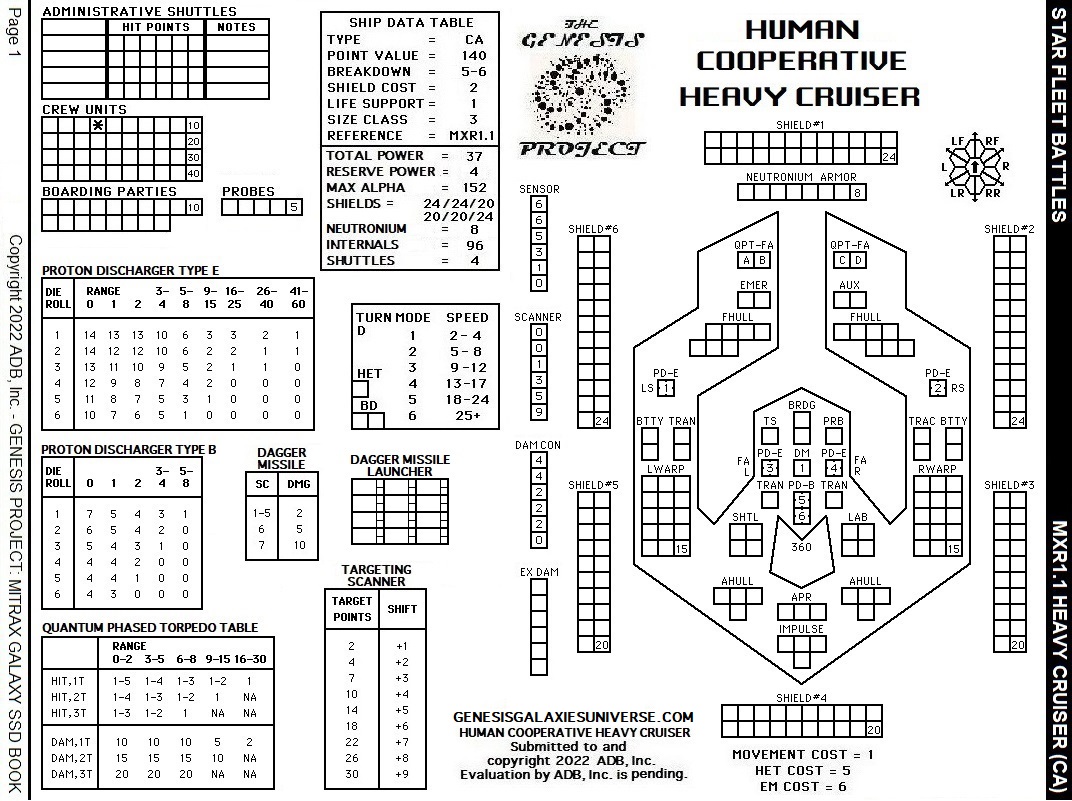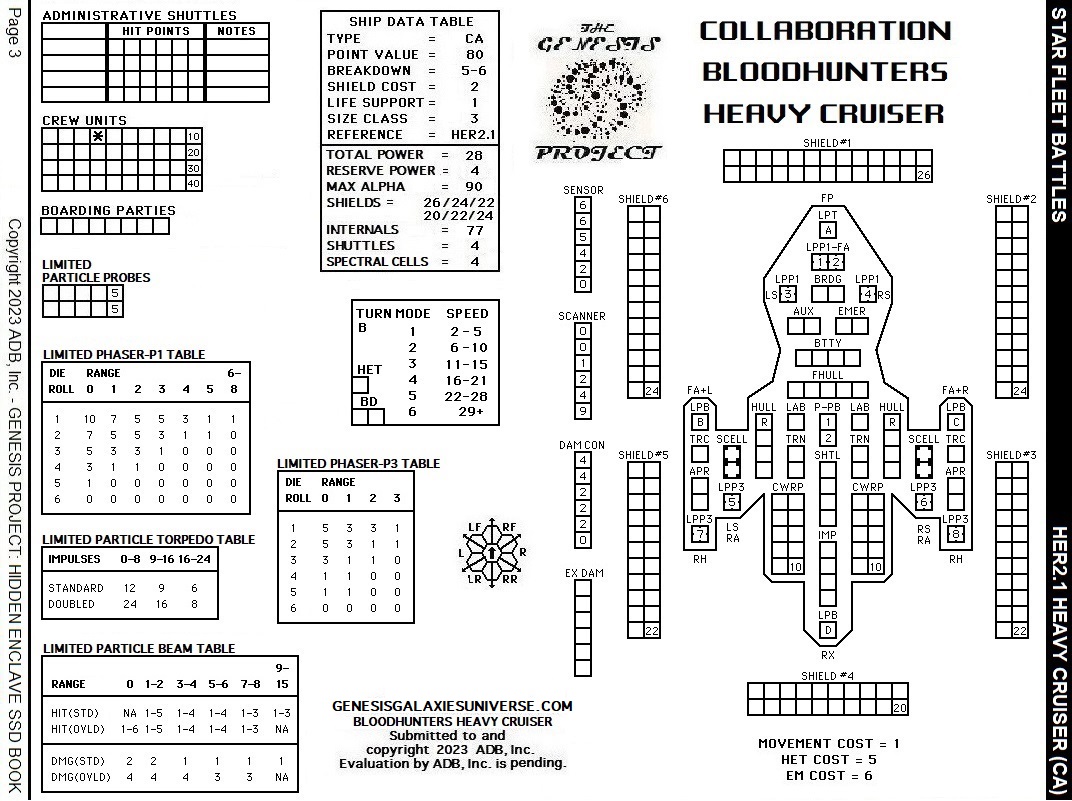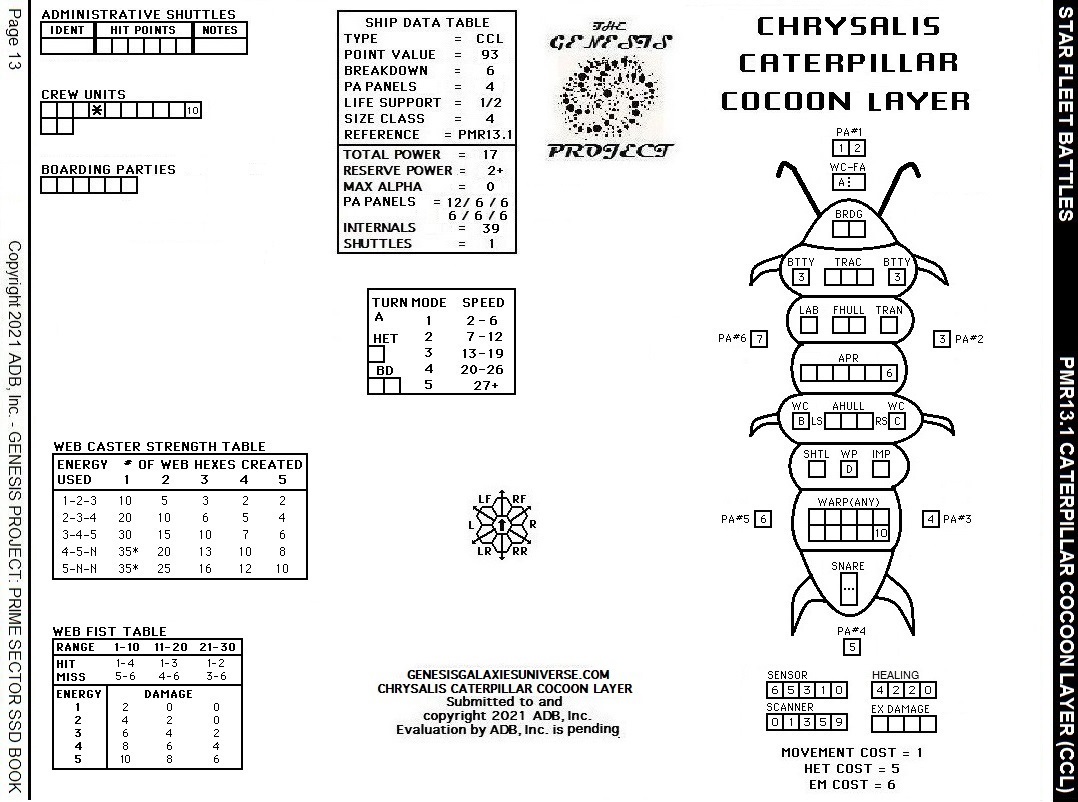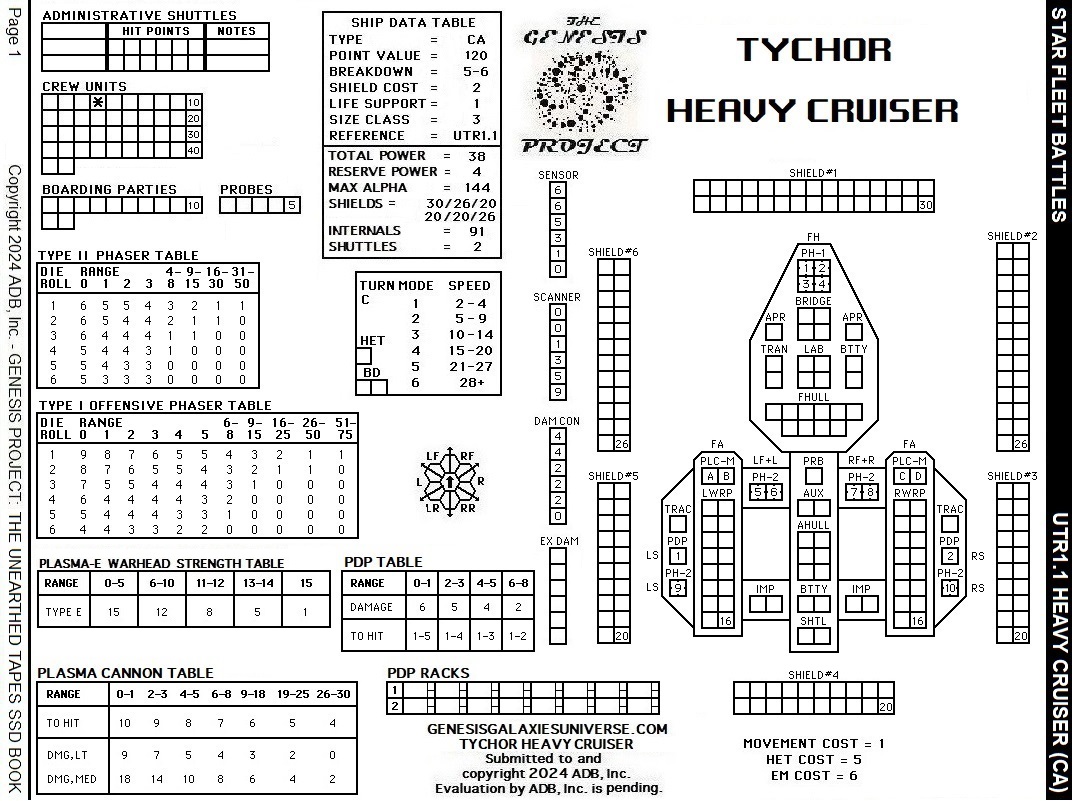THE MITRAX GALAXY
HUMAN COOPERATIVE SHIPS
(MXR1.1) HEAVY CRUISER (CA):
The Human Cooperative Heavy Cruiser was the workhorse of the Human Cooperative Fleet. Armed with Four Quantum Phased Torpedoes, Four Proton Dischargers Type E, Two Proton Dischargers Type B, and one Dagger Missile Launcher, the Human Cooperative Heavy Cruiser was a fearsome opponent in combat. A built in Targeting Scanner was vital in battle, improving the accuracy of both the Quantum Phased Torpedoes and the Proton Dischargers. Critical Systems aboard the Human Cooperative Heavy Cruiser were protected by a layer of Neutronium Armor. The Human Cooperative Heavy Cruiser was well known for carrying squads of Battle Armor and Powered Battle Armor.
DESIGNER NOTES:
Examining the Proton Pulse Emitters was the first task in designing the Human Cooperative Heavy Cruiser. As the Sigvirion use Pulse Emitters (PE) in the Omega Sector, I had a problem with the name Proton Pulse Emitters (PPE). They were too similar for my taste. The decision was made, therefore, to rename the Proton Pulse Emitters as Proton Dischargers (PD) in the Mitrax Galaxy.
The Proton Discharger Type E immediately caught my eye. This type of “Phaser” can score up to 14 points of damage at close range and roughly the amount of a PH-1 at Ranges 3-4. My initial thought was that this was way too powerful for a Phaser mounted on a ship. Then I noticed that the Proton Discharger Type E costs 2 Points of Energy to fire, making its energy requirements akin to a PH-4. This made the weapon a little better, making it something in-between a PH-4 and a PH-1. But was it still too powerful?
Another way that the Proton Discharger Type E was balanced out was that they are limited in quantity on the Human Cooperative Heavy Cruiser. While a Federation Heavy Cruiser has 6 PH-1’s (that can fire forward), the Human Cooperative Heavy Cruiser only carries 4 Proton Dischargers Type E. That helps to mitigate the higher damage output.
I had seriously considered putting a limitation on the Proton Discharger Type E by requiring that it Cool Down for one turn after each firing. That would certainly even out the damage output. But then I thought of each turn that the Proton Discharger was Cooling Down and the opposing starship still being able to fire its “Phasers.” It seemed like an unfair advantage, even if the Human Cooperative Heavy Cruiser only fired two of its Proton Dischargers Type E at a time (allowing them to fire them every turn, just half in quantity). So I scrapped the Cool Down idea and kept the Proton Discharger Type E as it was, even with the high damage output. I can only hope that the reduced quantity (four) on a Heavy Cruiser would be sufficient for Balance. Only Playtesting will confirm that.
The Proton Discharger Type B was like a PH-2 that was very Limited in Range. That was fine with me. It even had a Reduced Energy Cost (fractional). So I left the weapon as Francois originally designed it.
The second item to be looked at was the Quantum Phased Torpedoes. I immediately knew that this weapon needed some revision. Francois originally had this weapon arm over three turns and score either 12 points (standard) or 20 points (overloaded). In his Triangulum (second) version, he lowered the arming to only two turns, but this did not solve the inherent issue with the weapon.
Compared to the Photon Torpedo and the Disruptor Bolt, the Quantum Phased Torpedo has some issues. Why would you wait three turns to score only 12 points of damage? And if you lower the arming cycle to only two turns, then you are generating 20 points of damage in only two turns. That is too much, considering that a Photon Torpedo has a maximum of 16 points of damage when overloaded over two turns.
So my solution was a bit radical. I gave the Quantum Phased Torpedo a One Turn Feature to make it similar to a Disruptor. It has a Two Turn Feature to make it similar to a Photon Torpedo. And it retains the Three Turn Arming wherein it can score 20 points of damage. This Range of Arming gives the Human Cooperative more tactical flexibility in combat.
Now Francois’ original concept was that the Quantum Phased Torpedo was a powerful Heavy Weapon with terrible To-Hit Chances. I kept this concept, but only for the Three Turn Arming. The One Turn Arming has decent changes to To Hit, while the Two Turn Arming is slightly worse. This means that the more damage the Quantum Phased Torpedo can score (and the Longer it is Armed), the worse its To-Hit Chances get. This made sense to me while solving several other issues at the same time.
In addition, the One Turn Arming has a slightly better Energy:Damage Ratio, the Two Turn Arming is just a little better, and the Three Turn Arming is a straight 1:2 Energy:Damage Ratio.
Francois created the Quantum Phased Torpedo with intriguing damage curves. It incorporates both Photon Torpedo Like Damage (remaining constant) and Disruptor Like Damage (dropping off with range).
Francois’ original design for the Quantum Phased Torpedo included built in ECM for the target. This seemed overly complex and unnecessary to me, since the To Hit Chances already reflected how bad the Quantum Phased Torpedo was at hitting. Furthermore, the Targeting Scanner provides an Improved Chance To Hit, so there seemed to be a Contradiction in building an inherent ECM for the target into the Quantum Phased Torpedo.
The Dagger Missile was an interesting Defensive Weapon. This weapon resembles the Short Range Cannon, but is a Seeking Weapon instead (not sure who thought of the idea first). Francois originally had the weapon designed so that it could only fire in Packs of 3 Missiles at a time, each with a Different Target. If only one Dagger Missile was needed, the other two Dagger Missiles were simply lost in the exchange. I didn’t particularly like this fact, considering that the Human Cooperative would not have wasted their valuable Dagger Missiles in such a fashion. So I implemented a change whereby the Human Cooperative Player could choose to fire 1-3 Dagger Missiles at their option, depending on their tactical need at the moment. I think this solution works much better, makes each Dagger Missile count, and makes sense logically.
I have always like the idea of Neutronium Armor used in Triangulum and believe that most of the Mitrax Galaxy should use it as a Standard Defense. However, I didn’t agree with the Triangulum version that defined Neutronium as FH and RH. So if the RH Neutronium is destroyed, but the FH Neutronium is not, the BRIDGE is protected from the Front but not the Back? This didn’t make sense to me. In the Mitrax Galaxy, therefore, the Neutronium Armor is always 360 degrees.
To balance out the protective nature of the Neutronium Armor, the Shields on the Human Cooperative Heavy Cruiser were appropriately reduced. A 30 point strike will breach one of the forward Shields, but the Neutronium Armor will pick up some of these internals if they hit Critical Systems on the DAC.
The Targeting Scanner used by the Human Cooperative gave me the most thought (and still does). This Device creates an EW Type of Shift, but at a much cheaper cost than EW. My concern is that this may be Unbalancing during a game. After staring at the numbers for hours, reviewing the EW Rules, reviewing the Targeting Scanner Rules, and staring at the EW Shift Chart, I cannot decide if this Device is Balanced or Not. So I left the Device as originally designed, resigning to let Playtesting make the Final Determination.
The Human Cooperative also uses Battle Armor and Powered Battle Armor, more ideas that need to be thoroughly tested during Playtesting.
In summary, the Human Cooperative Heavy Cruiser carries Powerful Direct Fire Heavy Weapons with Flexible Arming Cycles and Bad To Hit Chances. This is tempered by the Targeting Scanner, which can Improve To Hit Chances. The Proton Dischargers Type E can score much more damage than a PH-1, but costs more to arm and is limited in quantity on the Human Cooperative Heavy Cruiser. Dagger Missiles are Short Range Seeking Weapons that score Damage Based on Size Class. They can also launch at Different Targets at the Same Time. The Human Cooperative Heavy Cruiser is protected by Neutronium Armor, but its Shields has been reduced as result.
The Human Cooperative Heavy Cruiser forms the Perfect Beginning for the Mitrax Galaxy. It is reminiscent of the Federation Heavy Cruiser with its Powerful Direct Fire Weapons and Supplemental Seeking Weapon. Even the very name of Human Cooperative conjures up images of the Benevolent Federation helping others throughout the galaxy.
QUANTUM PHASED TORPEDOES (QPT):
* May be armed for one turn, two turns, or three turns
* Arming in one turn requires four points of energy. One turn arming cannot be Held. If not fired, the energy is lost.
* Arming in two turns requires three points of energy on the first turn and four points of energy on the second turn. Two turn arming can be Held at a cost of three points per turn.
* Arming in three turns requires three points of energy on the first turn, three points of energy on the second turn, and four points of energy on the third turn. Three Turn arming can be Held at a cost of five points per turn.
* There is No Upgrading one type of arming to another. The type of arming must be noted on the EAF during Energy Allocation.
* Quantum Phased Torpedoes are destroyed on TORP Hits on the DAC.
Treat Quantum Phased Torpedoes as Photon Torpedoes in all other respects not noted above.
DAGGER MISSILES (DM):
* Dagger Missiles use a Dagger Missile Launcher. The Dagger Missile Launcher holds 12 Dagger Missiles and has 2 Sets of Reloads.
* During the Energy Allocation phase of any turn a ship can take a Dagger Missile Launcher offilne and reload One Full Set of Reloads. During that turn the Dagger Missile Launcher cannot launch any Dagger Missiles.
* The Dagger Missile Launcher can fire 1-3 Missile Daggers every 12 impulses.
* Dagger Missiles are 360 degrees.
* If more than one Dagger Missile is launched in a single impulse, each Dagger Missile must have a different target assigned at the moment of launch.
*At the moment of launch any target within 8 hexes of the launching ship is a viable target.
* Each Dagger Missile has a Speed of 32.
* Dagger Missiles can turn or sideslip every impulse.
* Dagger Missiles can make 1 HET during its entire life. When a Dagger Missile uses its HET, it loses its movement for that impulse.
* Dagger Missiles have 1 damage point, meaning 1 point of damage scored on a Dagger Missile will destroy it.
* Dagger Missiles can stay on the board for up to 16 impulses, but must always stay within 8 hexes of its target or it is eliminated.
* Dagger Missiles don’t have EW, and cannot be lend any ECM or ECCM points.
* Dagger Missile Warheads are very small causing varying damage depending on the Target Size Class. Consult the Dagger Missile Chart on the SSD.
* Dagger Missiles are Self-Guided from the moment of launch, requiring No Channel.
* Dagger Missiles can track a target in its FX arc.
* If a Dagger Missile Launcher is destroyed, all Dagger Missiles loaded in it are also destroyed, but not the Reloads. Dagger Missile Reloads are destroyed on the last Excess Damage Hits on the DAC.
* Dagger Missiles cannot be used as a Scatterpack, although something similar to a Scatterpack might be developed in the future for Dagger Missiles.
* Dagger Missile Launchers are destroyed on DRONE Hits on the DAC.
Treat Dagger Missiles as Drones in all other respects not noted above.
TARGETING SCANNER (TS):
* The Targeting Scanner has a Capacitor that can hold up to 30 Targeting Points.
* Every point of energy allocated to the Targeting Scanner will produce 3 Targeting Points that will be stored in the Targeting Scanner Capacitor. Energy can only be allocated to the Targeting Scanner during the Energy Allocation phase. This energy can come from any source.
* At the moment of firing a Quantum Phased Torpedo or Proton Discharger, the decision is made, using the Targeting Scanner chart, how many Targeting Points to put into each weapon. This must be announced before rolling the dice. The Targeting Scanner chart will indicate a shift based on the amount of Targeting Points.
* EFFECT WITH A QUANTUM PHASED TORPEDO: Add the Targeting Scanner shift to the Highest Chance to hit with the Quantum Phased Torpedo. The result can never be higher than 6. Do not use a different column.
* Example: At Range 8, a Two Turn Quantum Phased Torpedo has a 1-2 Chance To Hit. 7 Targeting Points are drawn from the Targeting Scanner Capacitor, resulting in a +3 Shift. 2+3=5, so the Modified Chance To Hit is now 1-5.
* EFFECT WITH A PROTON DISCHARGER: Subtract the Targeting Scanner shift from the Die Roll to hit with the Proton Discharger. The result cannot be lower than 1. Do not use a different column.
* Example: A Proton Discharger Type E is fired at Range 4. 4 Targeting Points are drawn from the Targeting Scanner Capacitor, resulting in a +2 Shift. A Die is Rolled To Hit with the Proton Discharger Type E and the result is a 5. 5-2=3, so 9 points of damage is scored.
* The shift created by using Targeting Points can be used to offset a target using ECM.
* The Targeting Scanner is destroyed on FLAG Hits on the DAC.
NEUTRONIUM ARMOR: Functions exactly as described under (DN102.0) in Module E2 except that Neutronium Armor in the Mitrax Galaxy is 360 degrees and not FH and RH.
BATTLE ARMOR AND POWERED BATTLE ARMOR: The Human Cooperative uses Battle Armor and Powered Battle Armor as detailed under (DN100.0) in Module E2.
PROTON DISCHARGER TYPE E (PD-E):
* Costs 2 Points of Energy to Fire.
* Cannot be Held.
Treat as Phasers in all other respects not noted above.
PROTON DISCHARGER TYPE B (PD-B):
* Costs 0.75 Points of Energy to Fire.
* Cannot be Held.
Treat as Phasers in all other respects not noted above.




